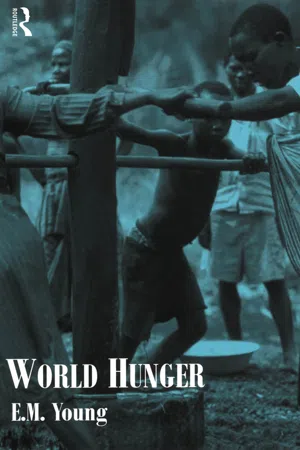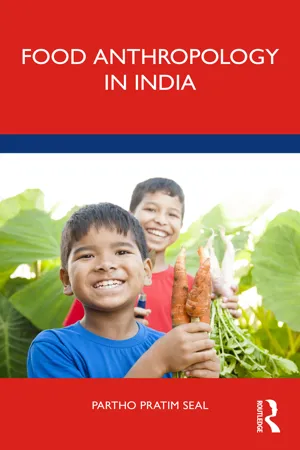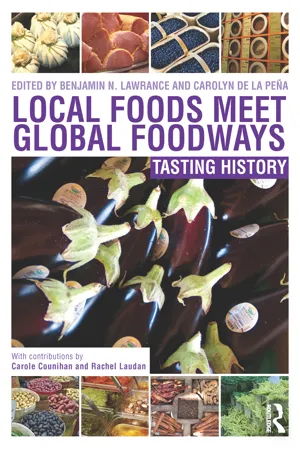Geography
New Foods
New foods refer to food items that have recently been introduced to a particular region or country. These foods may be the result of globalization, migration, or technological advancements in agriculture and transportation. The adoption of new foods can have significant impacts on local diets, economies, and cultures.
Written by Perlego with AI-assistance
Related key terms
Related key terms
1 of 4
Related key terms
1 of 3
3 Key excerpts on "New Foods"
- eBook - ePub
- Liz Young(Author)
- 2002(Publication Date)
- Routledge(Publisher)
There is ample evidence that the world food system is becoming increasingly integrated, so that who eats and who does not, and what they eat or do not eat, is now influenced by global processes which are quantitatively and qualitatively different from global processes in the past. This chapter overviews inherited international processes that govern access to food before detailing some of the most recent transformations of the global production, distribution and marketing of foods, which is creating new winners and losers in the competition over the production and consumption of food.The changing geography of global food production and consumption, from the sixteenth to the twentieth century
The geography and diffusion of plants and animals in the ancient world, from Mesopotamia and other agricultural hearths, is a fascinating study, and trade in luxury foods existed in the centuries before European expansion: the trans-Saharan salt trade; the wine trade, which connected the Mediterranean regions to Northern Europe; the trade in olive oil; the trade in eastern spices to Europe. However, these transactions never represented a significant element of the diets of the majority of people, or even of the diets of the élite. The great bulk of food production and consumption was localised until capitalism emerged and diffused with the European conquests. The focus of this section is on some of the more important connections made between regions and peoples and their diets since European expansion and colonisation, that is, some important foundations of the contemporary global food system.The discovery of the Caribbean as a sugar-producing system initiated a process of producing a food cheaply in one location and transporting it in large volumes to be consumed in another. The case study of northeast Brazil (see Box 2.3 - eBook - ePub
- Partho Pratim Seal(Author)
- 2023(Publication Date)
- Routledge India(Publisher)
Inglis, 2015 ). Globalised food is made up mainly of three distinct processes: circulation of food products as commodities internationally, the expansion of food corporations, and the governance of food globally.Globalising Commodities
As the new era of global regulations of food has begun, there has been a shift in food production which is more flexible, obtains higher profits, and has a great reach to multiple territories. The global food regime has helped to adopt standardised planting, picking, and packing practices in agriculture around the world. It includes sourcing and distribution of fresh fruits and vegetables and other livestock establishments and fisheries. Some analysts have discussed different labour relations like feminisation of labour to prepare food for exports. Orienting the local food to the world platform may affect the rural population of food securities because of monocropping. Researchers have also discussed the alternative approach which emphasises the cultural and historical approach as well as the network of the local agencies for globalising a specific commodity.Corporations
Food and globalisation are part of food-related transnational corporations. These food-related corporations share several characteristics of various global investments and control of the food industry in terms of what is grown, processed, distributed, or purchased. These transnational corporations are classified mainly on how food is produced and the way they distribute and trade food.The foods which are traded and marketed globally vary considerably depending on the culture of the nation. These food-related corporations are focused mostly on the cultural impact of their global outreach. The global proliferation of fast-food chains McDonald’s and Kentucky Fried Chicken (KFC) shows cultural imperialism. The expansion of these food corporations into the developing world has a negative impact on the nutrition level as these imported foods replace the local diet. This also negatively influences the population as there is evidence of an increase in the obesity level in developing nations. In developing nations, the introduction of supermarkets gave greater dietary choice to individuals who have the means, but it has made the smaller farmers more vulnerable as it weakens the local food flow to the markets, thereby affecting the local economy. - eBook - ePub
Local Foods Meet Global Foodways
Tasting History
- Benjamin Lawrance, Carolyn de la Peña(Authors)
- 2013(Publication Date)
- Routledge(Publisher)
We see this as a logical next step in the expanding domain of food and cuisine studies, the contours of which have recently been articulated by Carole Counihan and Penny Van Esterik. In the second edition of their now-standard reader, they ponder the mushrooming of the sub-field, and in particular how “food has permeated almost every scholarly field and become a widely accepted research topic.” Whereas when they embarked on their careers, food was “marginalized as a scholarly focus,” by the late 2000s, the proliferation in food, drink and cuisine research extends deeply into historical studies, anthropology, geography, ethnic studies, and sociology, and is also making significant inroads into human biology, archaeology, political science and economics. 7 As an intellectual project, this volume emerged from an ongoing conversation about food, drink, and globalization between two scholars – one seeking to write a book about the history of a foodstuff and its attendant foodways; and the other exploring how to teach the emergence of food and cuisine within a global historical context as a vehicle for the examination of geopolitical change and social history. 8 This book represents a concerted effort to ground our common interests in the narratives of things within the dynamic “global” communities that produce, transport, and consume them. Alexander Nützenadel and Frank Trentmann have forthrightly observed that although food and globalization “are inseparable,” financial markets, migration narratives, communication concerns and trans-national political contingencies have often overshadowed the contours of food globalization. 9 Popular histories of commodities and luxuries have done little to undercut this, however
Index pages curate the most relevant extracts from our library of academic textbooks. They’ve been created using an in-house natural language model (NLM), each adding context and meaning to key research topics.
Explore more topic indexes
Explore more topic indexes
1 of 6
Explore more topic indexes
1 of 4


